MARIANI’S
August 3, 2008
NEWSLETTER
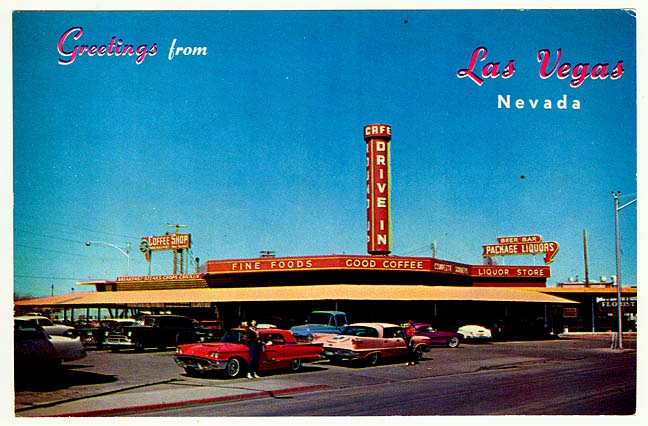
NEW! Click esquire.com
to go to my new column at Esquire Magazine.
ARCHIVE: Readers may now access
an
Archive of all past newsletters--each annotated--dating back to July,
2003, by simply clicking on www.johnmariani.com/archive
SUBSCRIBE AND
UN-SUBSCRIBE: You may subscribe anyone you wish
to this newsletter--free of charge--by
clicking here.
In
This Issue
WHAT PRICE
GLORY? DINING DELUXE IN PARIS AT
LES AMBASSADEURS
by
John Mariani
NEW YORK
CORNER: 15 EAST by Mort Hochstein
QUICK BYTES
~~~~~~~~~~~~~~~~~~~~~~~~~~~~~~~~~~~~~~~~~~~
WHAT PRICE GLORY? DINING DELUXE IN PARIS at Les Ambassadeurs
by John Mariani
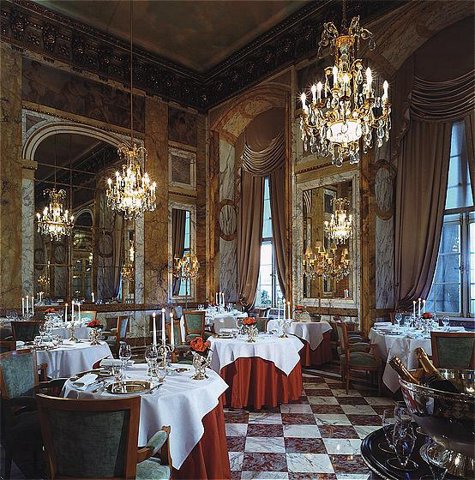 The obnoxious cliché, "If you
have to
ask, you can't afford it," originally uttered (in a slightly different
form) by American financier J. P. Morgan, has become a kind of
knee-jerk defense
mechanism for things that are a) worth every penny, b) patently
exorbitant,
or c) not at all worth the money.
The obnoxious cliché, "If you
have to
ask, you can't afford it," originally uttered (in a slightly different
form) by American financier J. P. Morgan, has become a kind of
knee-jerk defense
mechanism for things that are a) worth every penny, b) patently
exorbitant,
or c) not at all worth the money. It was Oscar Wilde who, more pointedly, wrote, "Nowadays people know the price of everything and the value of nothing."
Les Ambassadeurs at Le Crillon
The anemic state of the U.S. dollar has put both these observations into sad focus for anyone visiting Paris these days, not because you can't eat relatively cheaply at a small bistro (figure $50 per person), but because the Michelin star-rated restaurants are among the most expensive in the world: An appetizer can easily run $85, a main course $120 (service and tax included). To dine at the three-star level is going to run a couple, with, say, a $100 bottle of wine, at least $400, and easily more. And for that, exactly what do you get?
The answer once was easy: The glory of French haute cuisine was, until recently, to be found at the star restaurants, where the owner or chef might employ 25 people in the kitchen and 20 in the dining room (including a sommelier or two) to serve no more than 40-50 people a night, one sitting, beginning at eight P.M. and ending at 11. Such a restaurant might serve lunch, and if so, the price for a meal was the same. There would be the finest in furnishings (not necessarily the same thing as taste), and the wine cave would stock hundreds of selections and thousands of bottles, mostly the greatest of Bordeaux and Burgundy, and plenty of Champagne.
These were always celebratory places for Parisians, once-in-a-lifetime places for tourists, and de rigeuer for a serious business lunch or dinner. The food, if not always exquisite and imaginative, was always correct and always extremely rich, with oceans of butter-based sauces, trawlers of caviar, pails of foie gras, and shovels of black truffles. All the classics were on every menu, all made from the most expensive ingredients--Bresse chickens, Dover sole, Charolais beef, and Gevrey-Chambertin in the sauces. And it all cost a fortune.
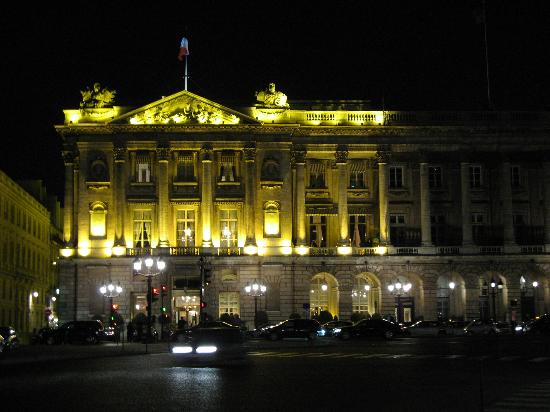
What has changed in France, as elsewhere, is that you can dine splendidly and with more excitement and spirit at smaller, chef-run restaurants that offer a very personalized cuisine without always resorting to foie gras, caviar, and truffles to bulk up their checks. Some of the finest eating in Paris right now is at charming places where you can feast on lesser cuts of meat, fish like red mullet and sardines, guinea fowl, regional cheeses, and wines carefully selected to go with the food. Even the Michelin Guide lists some terrific places under the category of "Bib Gourmand"--restaurants with quality cuisine for a maximum price of 35€," including darling spots like Chez l'Ami Jean, Graindorge, L'Épi Dupin, and Aux Lyonnais.
Why, then, spend ten times that amount to eat at a two- or three-star restaurant (which, more than a little ingenuously, Michelin contends are based solely on the food on the plate, not the atmosphere or service)? Having had too many mediocre or dull meals at such restaurants--most recently a dreary repast at the ugly two-star Senderens--it is a question I keep always in mind, especially since it is the question my readers ask most often. The answer is not to quote, once again, J. P. Morgan, but to say that there are two- and three-star meals I have enjoyed immensely--not just for the food on the plate but for the breathtaking beauty, refinement, finesse, and wonder of the entire evening.
Restaurants like Le Bristol in the Bristol Hotel, Le Cinq in the Four Seasons Georges V, Arpège, Michel Rostang, Taillevent, and Guy Savoy, are, each in its own way, sumptuous, memorable dining rooms with exquisite food and wine. Most recently this glory was evidenced with exceptional savoir-faire at Les Ambassadeurs in the Hôtel de Crillon (above). (These days no individual chef can afford to open up an haute restaurant without the benevolence of a grand hotel's backing.) The Crillon itself, right on the spectacular Place de la Concorde, next to the American Embassy, and backing onto the Rue Faubourg, is one of Paris' true château hotels, commissioned in 1758 by Louis XV and in the Crillon family until 1907, when it became a hotel, opening in 1909. Since then its guest books have been crammed with the most famous names of the 20th and 21st centuries, from Theodore Roosevelt to Jennifer Lopez, and it has never been in better, more elegant shape, with a concierge and reception staff in a gorgeous lobby that is first class in every degree.
 Les
Ambassadeurs has always had a good, if sedate history, serving a
classic menu with a few flourishes--at least until the arrival of Chef
Jean-François Piège, 38, (left),
previously one of Alain Ducasse's acolytes. Piège, from the
Drôme
region, also worked at the Crillon some years ago under long-time chef
Christian Constant, so he knew the run of the place and how he wanted
to
change the cuisine. His focus is on deceptively simple plates--a few
perfect ingredients composed in such a way that they appear like
novelties of form but retain every bit of their essential, enhanced
flavors.
Les
Ambassadeurs has always had a good, if sedate history, serving a
classic menu with a few flourishes--at least until the arrival of Chef
Jean-François Piège, 38, (left),
previously one of Alain Ducasse's acolytes. Piège, from the
Drôme
region, also worked at the Crillon some years ago under long-time chef
Christian Constant, so he knew the run of the place and how he wanted
to
change the cuisine. His focus is on deceptively simple plates--a few
perfect ingredients composed in such a way that they appear like
novelties of form but retain every bit of their essential, enhanced
flavors.One evening with two friends, I let Piège compose menus of several entrées (appetizers), seafood, and meats, followed by a "variation des grand desserts à la Française." It would take a great deal of space to describe everything we ate that evening, but a few of the highlights included a salad of beets in fizzy "limonade," with the beets providing the sweetness to the tartness of the citric. There was a cromesquis of brandade de morue--the ultimate baccalà!--with a bonbon of truffle butter to pop in the mouth.
Perfect, translucent scallops came with a little pizza-like tarte flambe, and wild turbot done "viennoise" style, with a side of tomato spaghetti and diced truffles--typical of the way Piège has a little fun with old concepts turned on their head to make something wondrously new.
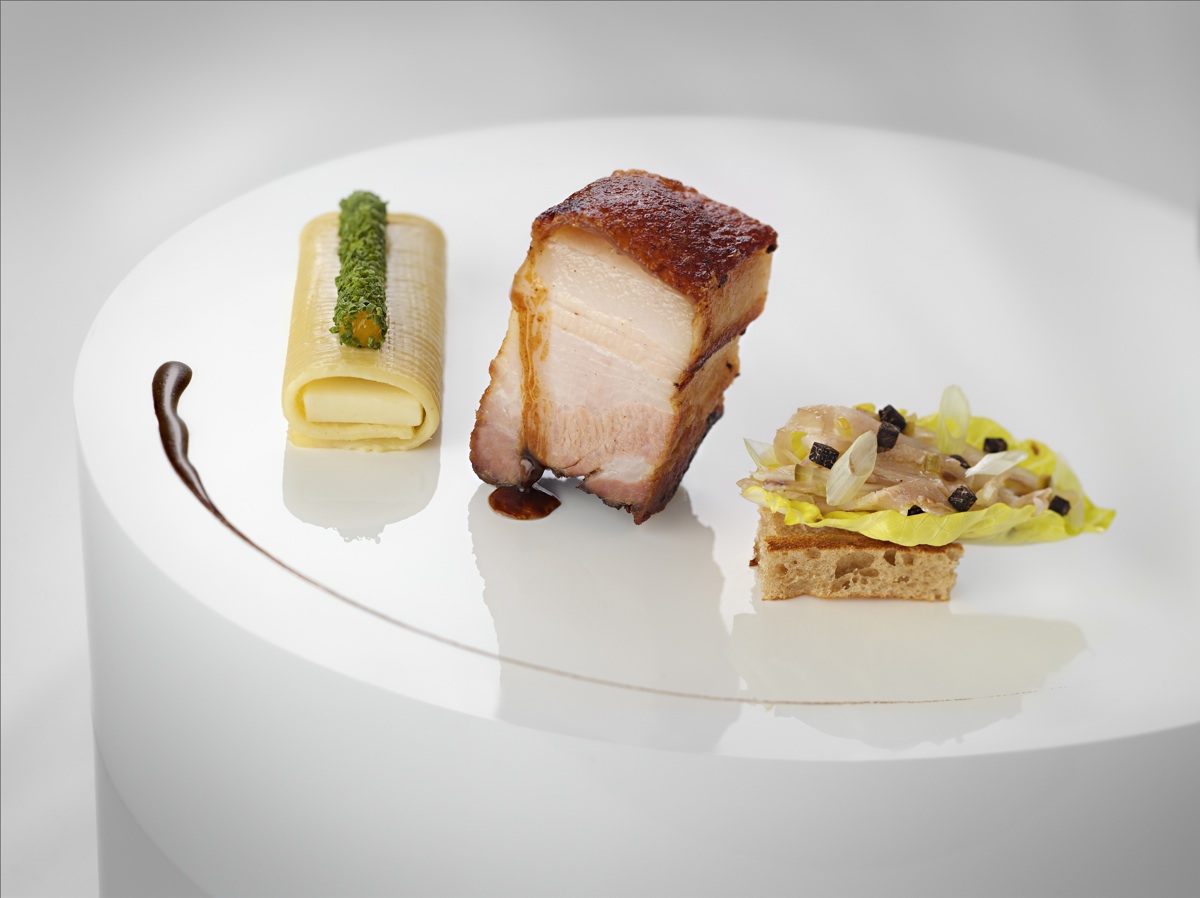 Equally witty and delicious was his
take on "spaghetti carbonara" with lard
de ferme (right), in
which the bacon mimics the guanciale
used in Roman spaghhetti alla
carbonara, while pork head cheese added a Gallic
touch.
Equally witty and delicious was his
take on "spaghetti carbonara" with lard
de ferme (right), in
which the bacon mimics the guanciale
used in Roman spaghhetti alla
carbonara, while pork head cheese added a Gallic
touch. One of his signature dishes is a beautiful rendering of langoustines, sushi, shellfish, in a bouillon laced with "caviar d'Aquitaine," with both sturgeon and lobster roe. Squab came with duck foie gras and olive juice, as close to something classic as Piège's menu gets.
All around us, at widely separated tables, were Parisians having a grand old time, a few very quiet Japanese, and some eastern Europeans who seemed delighted merely to sit in the splendor of this richly marbled, beautifully lighted, baroque dining room, once the Duke of Crillon's ballroom and recently refurbished by interior designer, Sybille de Margerie, who has brightened the room and given it far more warmth than it used to have.
The service staff could not be more attentive--there are two dozen in the room!--the pouring and selection of wines, under sommelier David Biraud, the service of cheeses and desserts and petits-fours and chocolates all conspiring to make this grand and very expensive meal worthwhile--but certainly not for the splendor alone: Piège is one of Paris' finest chefs, and author of a cookbook showcasing his style, Côte Crillon/Côte Maison, coming out in English this fall as At the Crillon & Home.
So, is it worth it? Yes, I believe it is, in the same way a great performance by a great actor in a great play is worth paying for expensive tickets. Les Ambassadeurs is, indeed, a great night of theater with many fine players.
NEW YORK CORNER
by Mort Hochstein
15EAST
15 East 15th Street
212-647-0015 (near Fifth Avenue)
15eastrestaurant.com.
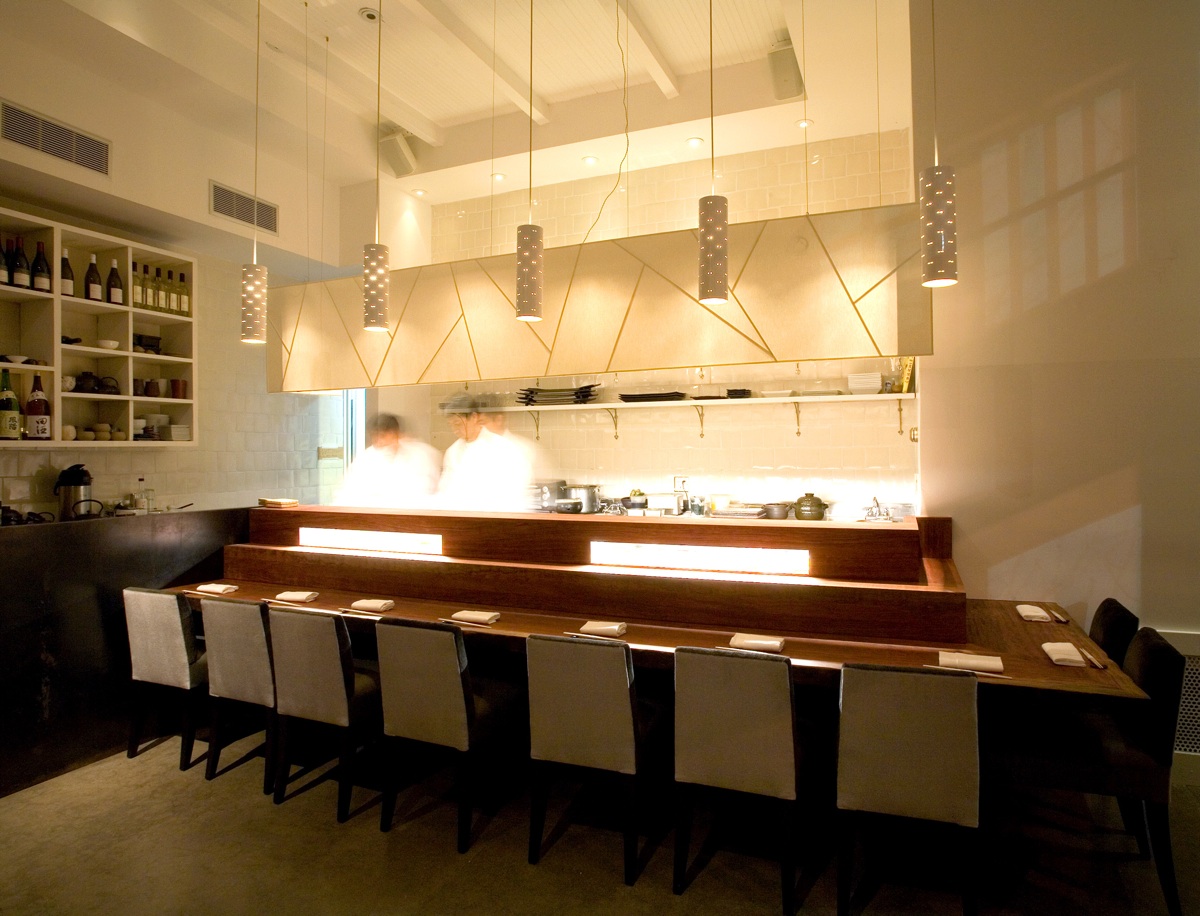 In
Japan a few years ago my wife and I dined luxuriously at a rooftop
restaurant high atop a five star hotel. We perched at the bar and
watched as chefs prepared miniature gems of food, small plate after
small plate, and passed them across the counter to us. I cannot
recall how many artful morsels of fish, meat and vegetables we enjoyed
but that evening is forever a high among my great culinary
experiences.
In
Japan a few years ago my wife and I dined luxuriously at a rooftop
restaurant high atop a five star hotel. We perched at the bar and
watched as chefs prepared miniature gems of food, small plate after
small plate, and passed them across the counter to us. I cannot
recall how many artful morsels of fish, meat and vegetables we enjoyed
but that evening is forever a high among my great culinary
experiences.
A few days afterward we were deep in the country at the
type of small country inn the Japanese call a ryokan. In our room, whose great
windows overlooked a waterfall, we wore traditional robes
and dined in solitary splendor. Again, small plate
after small plate was set before us, ever so gently and
unobtrusively by a woman, robed traditionally, who
delivered us food cooked silently at a stove not visible from our
dining area and gracefully backed away from our table after
each visit. That was great Japanese dining experience number two.
During that trip we ate at small and large
restaurants, venturing into foods only distantly related to
the limited repertoire of yakitori and sushi we knew at
home. home. In New York recently, I entered 15
east, a small
Japanese
restaurant hoping to recreate those first two ‘highs.’ The
restaurant takes its name from its location on East 15th Street, just a
few steps away from Union Square and the Farmers’ Market, and close to
its
elder sibling, the large and bustling Toqueville.
Its proprietors, husband and wife Marco Moreira and Jo-Ann Makovitzky,
enlisted Masato Shimizu, a talented young sushi chef who formerly
worked at Jewel Bako, further south on East 5th Street, to bring
upscale Japanese cuisine to a neighborhood largely populated by
restaurants catering to a boisterous after work crowd. Shimizu
and his knife- wielding crew are almost the first people you see as you
enter the brightly lit front room where they work.
Seats at the bar (above)
close to the chef would have been ideal, but those are prime locations,
spoken for long in advance. We sat instead at a corner banquette in the
less brightly lit dining room off the entryway (below). It was not a posh hotel
site nor was it a solemnly peaceful ryokan,
but there was a comforting look to the gray-walled room whose windows
look out on 15th street. Additional soundproofing on the wall
behind us and the ceiling above would have helped, particularly when we
had difficulty understanding the English of our otherwise faultless
Japanese servers.
Edamame,
those crackling young soybeans, lightly salted as an appetizer, can be
addictive, much like potato chips, only a bit more elegant. While
chomping away on the edamame,
we enjoyed a soup unlike any I’d ever had, a thick broth flavored
by wakame, a dark green kelp
and mitsuba, wild Japanese
parley and crowned with one delicate quenelle of fish. The taste
was like pea soup, but more delectable and flavorful. It
was the starter for an evening rich in wild seaweeds. We shared a
dégustation of sea lettuces--eight varieties
names like mozuku and hijiki, accompanied by a
sauces, among them a red-wine tinted mix based on
sesame and another flavored with soy and ginger. Those strange
black and olive and briny greens from the sea have given me a new
appreciation for seaweed.
And then there were those small, intense,
briny Kumamoto oysters, sharing a plate with lemony ponzu
granité, mitsuba and
house-pickled –chef Simizu does his own pickling--seasonal vegetables.
Small those oysters may have been, but they were big and fleshy
and tasty on the palate.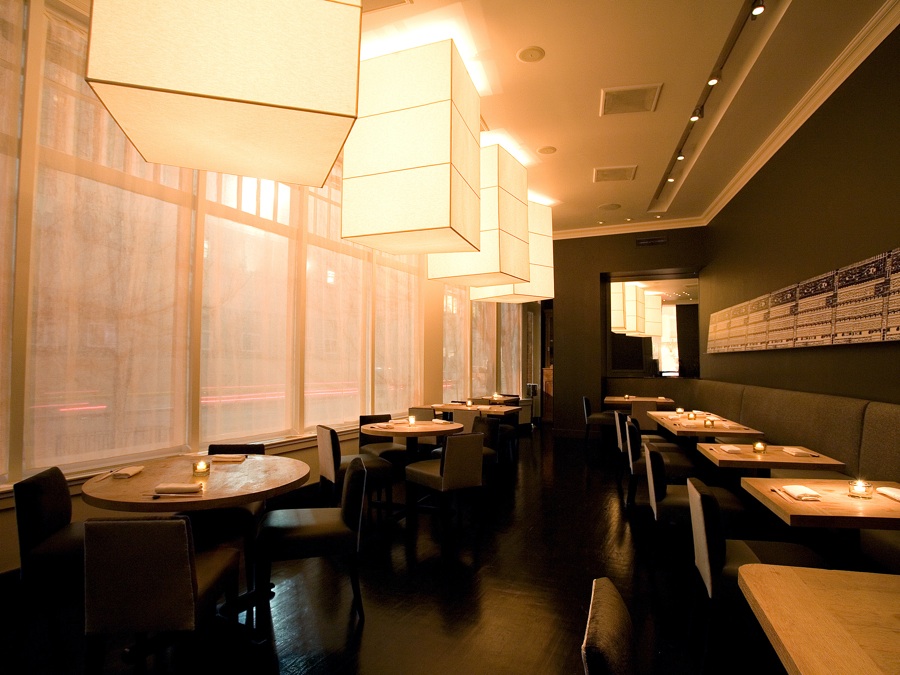
The
parade of plates went on and on, at a slightly faster pace than
our two experiences in Japan. Simizu sent out tako yawarakani, slow-poached
quarter-sized slices of octopus lightly spiced with sea salt, and a
trademark dish--diced blue fin tuna, guarded by grated Japanese yam (yamaimo) and topped by a quail egg.
If I found any fault, it was with an overly battered and flabby soft
shelled crab, almost saved by a tangy tomatillo sauce and accompanying
salad of baby mustard greens. Simizu’s skill with seafood is matched by
his expertise with sauces, particularly for us with a creamy caviar
dressing that made our sashimi and tartar of blue fin tuna
memorable.
This, after all, is a sushi and
sashimi house, and we ended the evening with platters of hamachi and shimaji from the
yellowtail family, suzuki and
hirami, wild striped
bass and fluke from the white fish side, three variations of
tuna, from lean to medium fatty and oh-toro,
most fatty. Unagi, eel, was
on our plate as was Japanese mackerel and steamed shrimp. They could
not
have been tastier, and being a fan of eel, I had two types, unagi fresh
water eel, and anago, from
the sea, new to me. With our main courses,
we also enjoyed servings of cold sake, Hokkaisan Hongozu and Sogen
Jumai, selected by our server from an extensive list.
While we did not have that discreet
Japanese woman as our chef-waitress for the evening, and while the room
was abuzz with New Yorkers, 15 east could not match the solemnity of
the one we
enjoyed in an Asian hideaway, but the evening came as close to equaling
the
pleasures of the ryokan
experience as any I’ve had in New York.
Tasting menus, seven
courses: sushi bar tasting menu, $120; From the sushi
bar, 16 East offers a sushi or sashimi omakase chef’s
choice at $55 and a 7-course menu at $120; sashimi-sushi combo at $95.
À la carte, the menu ranges from $24-$45\. From the sushi
bar, there is a seven-course
tasting menu for $120; Open for lunch Mon.-Fri. and
dinner Mon.-Sat. Closed Sun.
Mort
Hochstein, former editor and producer for NBC News and the Today Show,
and former managing editor of Nation's Restaurant News, has
written on wine, food and travel for Wine Spectator, Wine Business
Monthly, Saveur and other food and wine publications.
~~~~~~~~~~~~~~~~~~~~~~~~~~~~~~~~~
NOTES
FROM THE WINE CELLAR
The
Business of Wine—Not Romance--Is the Subject of Wine Politics
Review by John Mariani
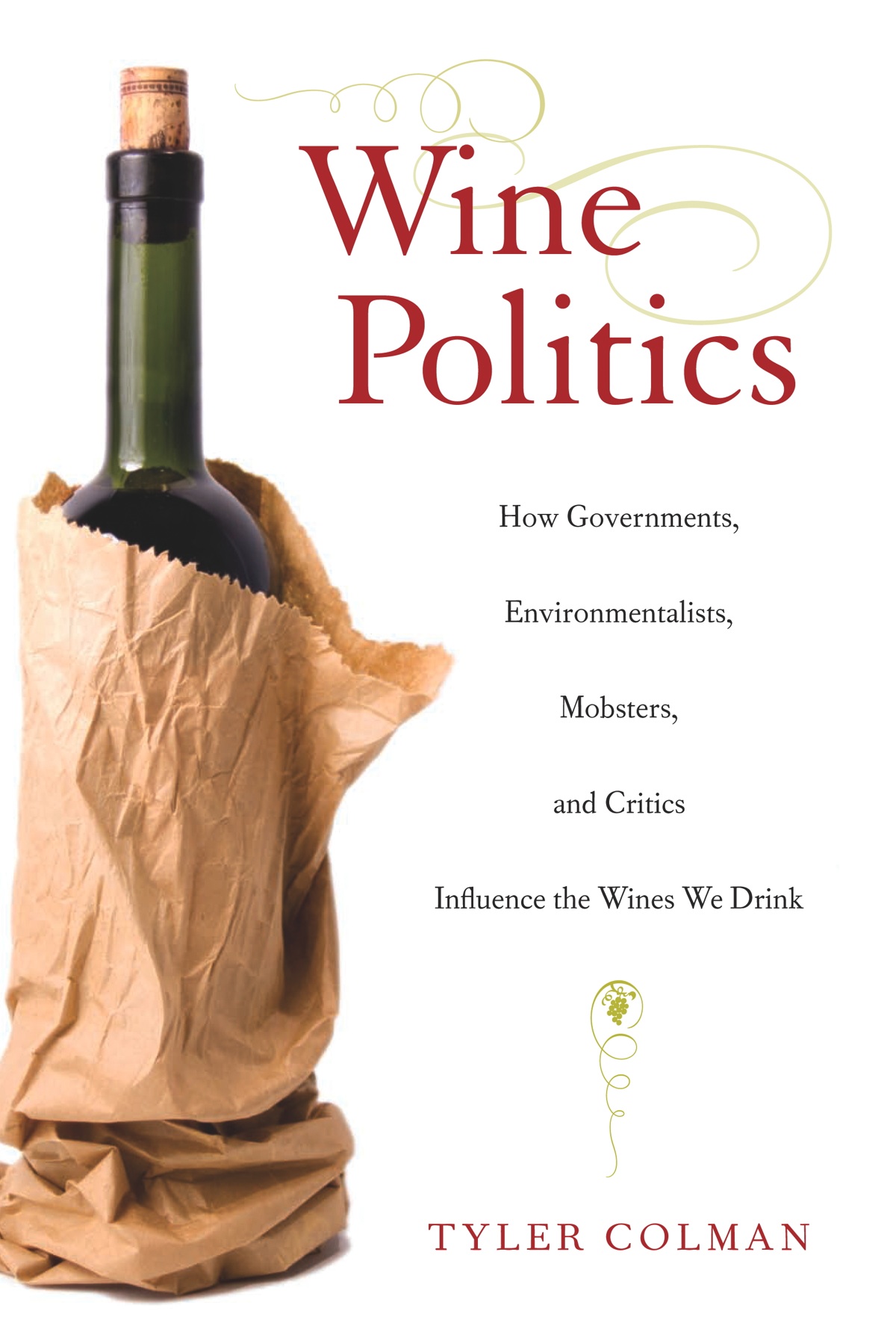 You mean you really believe wine is about God
and Nature, family sagas, and romantic reveries of a year in Provence?
You mean you really believe wine is about God
and Nature, family sagas, and romantic reveries of a year in Provence?
Read Tyler Colman’s new book, Wine Politics (University of
California Press, 206 pages, $27.50) and be dissuaded.
The subtitle alerts you to the myths that
Colman, who teaches wine classes at New York University and the
University of Chicago, seeks to dispel: “How Governments,
Environmentalists, Mobsters, and Critics Influence the Wines We Drink.”
That’s actually a bit more provocative than the book is—-mobsters are
few and far between in these pages—but the solid reporting and historic
perspective Colman provides clearly indicates that the enjoyment of
wine has little to do with the way it is made, labeled, sold,
distributed, and marketed. Wine, since the 19th century, has been
big business and it gets bigger all the time.
Gallo, still privately held, sold an estimated
75 million cases of wine in 2005, with sales of $3 billion, while the
mega-wine company Constellation, publicly traded, had sales of $4.6
billion. Between the two of them they control about one-fifth of the
wine sales in the U.S.
Colman focuses on France and the U.S.
wine industries, with the last chapters on the globalization of wine
production and distribution: Pernod Ricard owns brands in Australia and
New Zealand, and LVMH owns wineries on 5 continents. He deftly
chronicles French wine history, with its chronic booms and busts, and
the powerful role of bourgeois Bordeaux merchants—many of them English
and Dutch--whose geographic advantage on the Garonne River allowed for
swifter, more widespread distribution.
He also shows how France’s national wine
regulations, the first in 1905, were established by merchants to combat
fraud that made the contents of a bottle of Bordeaux or Burgundy a
farce of blends from the Languedoc, Sicily, even Algeria.
Colman skids lightly through U.S. wine
history, but his assessment of Prohibition and Repeal, shows just how
hopeless the Noble Experiment was, as bootleggers grew rich on hooch
sales while the wine-grape industry actually flourished because
homemade wine was allowed. By 1932, when the Depression had taken a
stranglehold on the U.S. economy, neither political party’s platform
had a plank of support for Prohibition. Labor unions lobbied for
its repeal because the liquor and wine industry provided much-needed
jobs. Repeal came quickly with the election of Franklin D.
Roosevelt.
Nevertheless, the government continues
to classify wine not as an agricultural product but as alcohol,
under the control of the Bureau of Alcohol, Tobacco, and Firearms,
whose name reeks of sin, sin, and sin. Of course, it’s still
easier to buy a gun than a bottle of wine in the U.S., and if you’re
under 21, forget the latter entirely.
Colman then delves into the byzantine
ways of those committees that pronounce on the appellations of wines,
like France’s Institut National des Appellations d’Originé
(INAO),
whose members (producers, merchants, INAO agents, critics) blind taste
the new wines soon after harvest. “If the wine fails to meet the
criteria of the appellations,” writes Colman, “it is `declassified’ or
downgraded to a vin de table.
. . .However, these tasting committees
have become toothless in recent years, as almost all wines pass.”
Which, of course, encourages more fraud
and scandal, as when the prestigious Cruse firm in 1973 labeled
non-Bordeaux wines as Bordeaux, precipitating a drop in prices
nation-wide that did not recover until the early 1980s.
One
can only shake one’s head over goofy U.S. laws like
Utah’s, which requires citizens to buy their wine and spirits only from
one of 36 state-run stores; Pennsylvania’s Liquor Control Board is
among the biggest wholesalers and retailers of wine in the country,
generating $1.5 billion is sales and a $350 million profit.
Colman has some fun with French
advertising restrictions, printing two ads showing the same pretty
woman holding a glass and smiling. The photo with her hair slightly
over one sultry eye, her lips barely parted, was rejected under the
anti-alcohol Evin Law; the one wit a nice, bright smile was
approved. Oh, and the woman had to be in the trade—winemaker
Catherine Gachet; no mere models need apply.
His treatment of environmentalists' impact on wine
focuses on sustainable agriculture, including the effects of too much
or too little water and how global warming will make winemaking
problematic in already hot regions, while a possible boon for colder
climates.
In his chapter on the wine media Colman zeroes in
(as does everyone) on the influence of Robert M. Parker, Jr., publisher
of Wine Advocate, whose
pronouncements can cause a rise or fall in sales of a winery within
days of being published. He does, however, believe Parker's influence
may be on the wane as Parker himself grows older and delegates
the ratings of wines in many regions to associates.
That Colman can contain so much history,
data, and anecdote in a highly readable 144 pages of text is to say it
is free from padding, despite evidence that some chapters started out
as a dissertation.
If the book is a little short on juicy
stories, rum runners and crooked pols, it goes a long way to dismiss
the silliness of wine advertising and the emptiness of so much wine
writing.
John
Mariani's weekly wine column appears in Bloomberg Muse News,
from which this story was adapted. Bloomberg News covers Culture from
art, books, and theater to wine, travel, and food on a daily basis, and
some of its articles play on the Saturday Bloomberg Radio and TV.
~~~~~~~~~~~~~~~~~~~~~~~~~~~~~~~~~~~~~~~~~~~~
GREAT IDEAS IN WESTERN FOOD CULTURE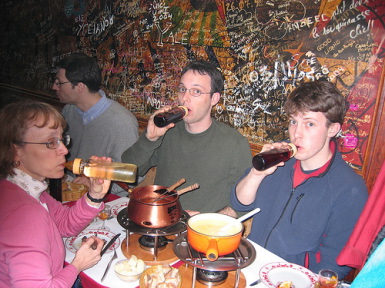
“For
the New
Yorker of a certain age, the first sip was a rite after nursing: from
mother’s milk to Manhattan Special. Those little glass bottles may as
well have come with nipples. And brother, what a sip. . . . It
muscles its way around the mouth, making itself at home, before
bounding down the throat like a big, goofy kid going to play in the
basement.--Michael Wilson, “A Modern Comeback for a Taste of Brooklyn,”
NY Times (July 7).
BUT
THAT'S HOW THEY
GET HERE!!!!
 A
Japanese brewery Sapporo Holdings plans to make "space beer,"
using offspring of barley once stored for five months aboard the
International Space Station in 2006. The
company teamed up with Okayama University biologist
Manabu Sugimoto to
explore ways to grow edible plants in space. First production will be only
about 100 bottles. Researchers
said the project "to prepare for a future in which
humans spend extended periods of time in space -- and might like a cold
beer after a space walk."
A
Japanese brewery Sapporo Holdings plans to make "space beer,"
using offspring of barley once stored for five months aboard the
International Space Station in 2006. The
company teamed up with Okayama University biologist
Manabu Sugimoto to
explore ways to grow edible plants in space. First production will be only
about 100 bottles. Researchers
said the project "to prepare for a future in which
humans spend extended periods of time in space -- and might like a cold
beer after a space walk."
QUICK BYTES
* On Aug. 2 & 3 the Great American Seafood Cook-Off will be held at the Louisiana Foodservice EXPO at the New Orleans Morial Convention Center, with cooking demos and judging throughout the day. $10 pp. Chefs prepare their dishes utilizing exotic seafood indigenous to their states incl.. For details, visit www.GreatAmericanSeafoodCookOff.com
* From Aug. 9-10 Alden-Houston
Hotel features a “grape escape” weekend package, hosted by
*17’s sommelier Evan Turner, and Houston sommelier Kim Wallace,
followed by a 5-course ‘farm to table’ dinner by Executive Chef Wes
Morton. Sunday brunch with guest winemakers Rick and Diane
DuNah of DuNah Winery. $287 pp. Visit
www.aldenhotels.com. Call 832-200-8843.
* From Aug. 13-31 the official Swedish crayfish season is
celebrated at London’s Fifth
Floor Restaurant and Café with Swedish Executive Chef
Jonas Karlsson serving a sharing dish of 12 boiled crayfish
priced at £15.95 for two people sharing, or £19.95 with the
addition of two shots of Schnapps. Visit www.harveynichols.com or
call 020 7823 1839.
* On Aug. 16 the fifth annual Toast of Ohio will take place in
Sandusky with help from the Ohio Grape Industries Committee., to
be held at the Sandusky Bay Pavilion. $1.00 admission fee, which
will feature 15 Ohio wineries. Live entertainment by the Bare Bones
Jazz Quartet. There will also be an Underground Railroad Trolley Tour
at 11 am. Visit www.shoresandislands.com.
* Royal Hideaway Playacar on Mexico’s Yucatan Peninsula, is offering a $7,000 Wine Class incl. a private wine class with wine expert, Olivier Cramail, a bottle of 1986 Petrus, and paired dinner on the beach. Call 1-800-999-9182 or visit www.royalhideaway.com.
* Now thru Jan. 31 in Weggis, Switzerland, the Park Hotel Weggis centers on its
extraordinary wine collection with a Parc & Wine package,
with rates starting at $1,790 per room, based on double occupancy and
season. Package incl. a complimentary bottle of Champagne
Perrier-Jouët upon their arrival. For a pre-dinner soiree,
aperitifs with the sommelier in the hotel’s wine cellar, a 5-course
dinner at the Restaurant Annex, two 4-course dinners at the hotel’s
Sparks Restaurant, and the Sparkling Breakfast Buffet daily. Visit www.phw.ch.
Everett Potter's Travel Report:

~~~~~~~~~~~~~~~~~~~~~~~~~~~~~~~~~~~~~~~~~~~~~~~~~~~~~~~~~~~~~~~~~~~~~~~~~~
Eating Las Vegas is the new on-line site for Virtual Gourmet contrinbutor John A. Curtas., who since 1995 has been commenting on the Las Vegas food scene and reviewing restaurants for Nevada Public Radio. He is also the restaurant critic for KLAS TV, Channel 8 in Las Vegas, and his past reviews can be accessed at KNPR.org. Click on the logo below to go directly to his site.
~~~~~~~~~~~~~~~~~~~~~~~~~~~~~~~~~~~~~~~~~~~~~~~~~~~~~~~~~~~~~~~~~~~~~~~~~~~
Tennis Resorts Online: A Critical Guide to the World's Best Tennis Resorts and Tennis Camps, published by ROGER COX, who has spent more than two decades writing about tennis travel, including a 17-year stretch for Tennis magazine. He has also written for Arthur Frommer's Budget Travel, New York Magazine, Travel & Leisure, Esquire, Money, USTA Magazine, Men's Journal, and The Robb Report. He has authored two books-The World's Best Tennis Vacations (Stephen Greene Press/Viking Penguin, 1990) and The Best Places to Stay in the Rockies (Houghton Mifflin, 1992 & 1994), and the Melbourne (Australia) chapter to the Wall Street Journal Business Guide to Cities of the Pacific Rim (Fodor's Travel Guides, 1991). THIS WEEK: A Report on The Four Seasons Jackson Hole. Click on the logo below to go to the site.

~~~~~~~~~~~~~~~~~~~~~~~~~~~~~~~~~~~~~~~~~~~~~~~~~~~~~~~~~~~~~~~~~~~~~~~~~
MARIANI'S VIRTUAL GOURMET NEWSLETTER is published weekly. Editor/Publisher: John Mariani.
Contributing Writers: Robert Mariani,
Naomi
Kooker, Suzanne Wright, John A. Curtas, Edward Brivio, Mort
Hochstein, Suzanne Wright. Contributing
Photographers: Galina Stepanoff-Dargery, Bobby Pirillo. Technical
Advisor: Gerry McLoughlin.
Any of John Mariani's books below
may be ordered from amazon.com by clicking on the cover image.
 My
newest book, written with my brother Robert Mariani, is a memoir of our
years growing up in the My
newest book, written with my brother Robert Mariani, is a memoir of our
years growing up in the For those of you who don't think of the Robert and I think you'll enjoy this very personal look at our --John Mariani |
 |
 |
 |
 |
 |
 |
© copyright John Mariani 2008
